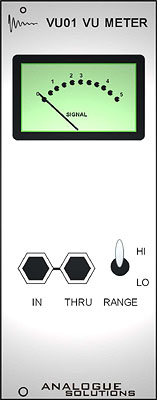
The VU01 is a moving coil meter as found on classic analogue synths like the EMS VCS3, or older style hi-fis and mixing desks. A VU meter is basically a device that shows voltage level via a moving needle. A VU meter is by no means an essential device, but it is a handy diagnostic to to check if signals are present (for instant non-audio signals like CVs), as well as giving a rough guide to intensity (voltage level). It will also make your modular system look that much better and give it an even more vintage look!
General information
A moving coil meter differs from the more modern LED bargraph in that it does not react
instantly to quick and big changes in voltage. It takes a small amount of time for the
needle to move to its new position. So if there are quick changes in voltage (like a fast
square wave), the needle may not have time to move to the new position before the wave
shape changes. The result is a moving coil gives a more ‘average’ reading of
signal.
1
Outputs:
Through
Power:
none
Controls:
Range HI/LO
Indicators:
Meter!
Size:
10HP